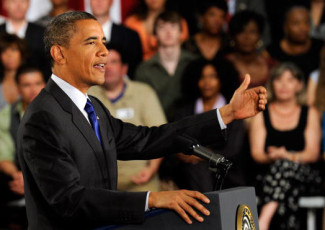A Look Back at Community Colleges in 2015
By Emily Rogan
December 30, 2015
Here’s what our readers were most interested in this year.
2015 was a landmark year for community colleges. In January, President Barack Obama announced his proposal to make community college free for any student willing to do the work. The president validated what business leaders and community college administrators across the nation have known for some time: Community colleges are a valuable and necessary piece in the larger puzzle of higher education and workforce preparation for the majority of people in America.
In fact, as most states have established completion agendas in an effort to increase the number of adults who have some form of postsecondary education, community colleges are sharing the spotlight with their four-year counterparts. According to a recent study released by the National Student Clearinghouse Research Center, the percentages of students in the fall 2009 cohort enrolled at public four-year and public two-year institutions were similar: 40.6 percent and 38.1 percent, respectively.
Over the past 12 months, community college leaders have improved developmental education and placement exams, clarified articulation agreements between two- and four-year partner institutions, improved perception through better marketing and public relations campaigns, developed creative fundraising strategies, enhanced advising and support services, helped make college affordable for more students than ever before and partnered with industry leaders to provide better pipelines to the workforce.
AACC has been following the trends, initiatives and efforts of its member colleges, chronicling successes and challenges. Here, we take a look at the 21st-Century Center’s most-viewed stories of 2015:
What About Tuition-Free Community College?
The president faced both support and criticism when he presented his vision of tuition-free community college. States such as Missouri, Tennessee and Illinois have already experimented with tuition-free community college initiatives, but not without financial and practical challenges. Read more.
Community Colleges Make Sense to Students
Cost, relevancy and a personalized educational experience are making community college a viable option for more students than ever before. Whether their intention is to transfer to a four-year institution or directly enter the workforce, community colleges are meeting students’ needs. Read more.
A Fresh Look at Placement Tests and Developmental Education
Developmental education often hinders students on the path to completion; many drop out before they even move into general education classes. In response, states across the country are taking a closer look at how students are tested and placed in courses and are trying some novel approaches, with successful outcomes. Read more.
Competency-Based Education Takes Hold
More than one community college piloted competency-based education (CBE) over the past year. CBE allows students to work at their own pace and demonstrate acquired knowledge in a practical way. CBE challenges conventional teaching practices, but as more students find success, it seems to be gaining popularity. Read more.
Advancements in Student Advising
As community colleges evolve to better meet students’ needs, one key area demanding attention has been advising services. Traditionally, community colleges have not offered the same level of support often found at four-year institutions — but that’s changing at a rapid pace. Many states have committed to intentional student advising, using technology and targeting students from day one. Read more.
Starting Earlier to Determine College Readiness
Gathering data earlier in students’ educational careers may help determine what they need to be college-ready and successful in postsecondary education. This report suggests that six factors have a profound impact on college readiness. Read more.






